 Iran’s Attack on Israel
Iran’s Attack on Israel
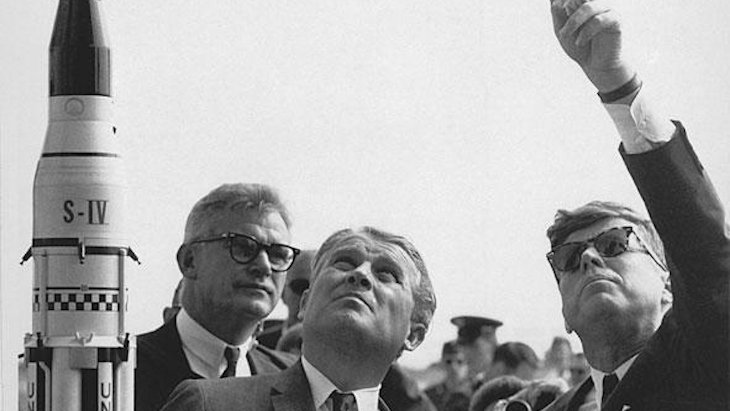

15 min read
The top-secret program brought 1,600 Nazis to America and whitewashed their past.
Operation Paperclip was a top-secret program that brought thousands of Nazi officials into the United States and helped them cover up their brutal pasts.
A major plotline of the TV show Hunters involves the uncovering of Operation Paperclip. The controversial series is fictional, but Operation Paperclip is based on a real program involving United States and other countries actively recruiting Nazi scientists to work on domestic weapons programs.
“Operation Paperclip” had its origins while World War II still raged. Starting in 1943, a top secret American military program called the Alsos Mission sent American scientists into Nazi Europe along with Allied troops: their mission was to search for information about the Nazis’ biological, chemical and nuclear programs and to transport that information back to the US.
At first, Alsos officials were able to make contact with Italian and later French scientists who’d worked for the Nazis, who assured the Americans that the Nazis were far from creating advanced non-conventional weapons. Alsos operatives made little progress in uncovering Nazi scientists’ weapons-making secrets.
Their luck changed in late 1944, during protracted fighting in the French town of Strasbourg. While fighting still raged outside, Samuel Goudsmit, a Dutch-born scientist working for the Americans under Alsos, made his way to the home of Dr. Eugen Haagen, a senior Nazi scientist who helped plan Nazi Germany’s feared biological weapons program. Haagen had fled just hours earlier, leaving his papers inside his luxurious apartment. With American soldiers guarding them, Dr. Goudsmit and his Alsos team stayed up all night reading through Haagen’s papers by candlelight.
They made for grim reading. “Of the 100 prisoners you sent me,” Dr. Haagen had written to a colleague, “18 died in transport. Only 12 are in a condition suitable for my experiments. I therefore request that you send me another 100 prisoners, between 20 and 40 years of age, who are healthy and in physical condition comparable to soldiers. Heil Hitler…” This and other papers showed that the Nazis were indeed moving full speed ahead to build potent biological, chemical and nuclear weapons.
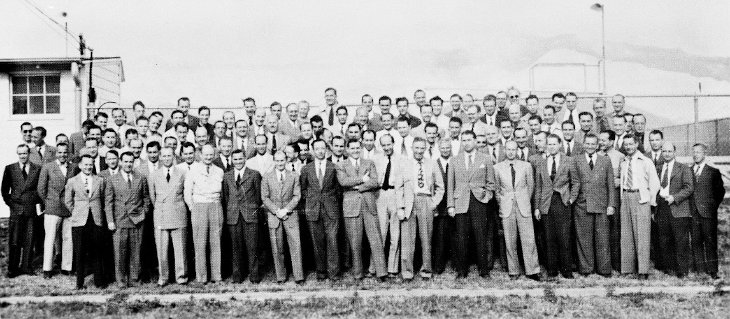 A group of 104 rocket scientists at Fort Bliss, Texas
A group of 104 rocket scientists at Fort Bliss, Texas
The Alsos officials made copious notes, writing down the names of scientists involved in these projects. Their goal wasn’t to bring these scientists to justice for their evil experiments. They were creating a list of scientists to track down, capture and interrogate. The United States was determined to learn what it could do about the diabolical weapons they were inventing.
“One by one, across the Reich,” explains journalist Annie Jacobsen in her book Operation Paperclip: The Secret Intelligence Program to Brought Nazi Scientists to America (Back Bay Books: 2014), “Hitler’s scientists were taken into custody and interrogated.” Two core goals emerged among Allied officers uncovering the extent of the carnage and horrors in Europe created by the Nazi regime. Many sought Nazis to arrest and bring to justice. At the same time, a key US and Allied goal was also to harness Nazi scientists’ technical know-how. “The scale on which science and engineering have been harnessed to the chariot of destruction in Germany is indeed amazing,” noted W.S. Farren, a British aviation expert with the Royal Aircraft Establishment. “There is a tremendous amount to be learnt in Germany at the present time.”
On July 6, 1945, the US Joint Chiefs of Staff issued a top-secret memorandum that was so explosive it was never even shown to President Truman. Titled “Exploitation of German Specialists in Science and Technology in the United States”, it outlined a program for “procurement, utilization and control of specialists” – in other words, a plan to recruit Nazi weapons scientists and bring them to the United States. The Military Intelligence of the War Department, a unit known as G-2, was given control of the program.
The US, as well as Britain, was engaged in an arms race with the Soviet Union. The Cold War was a terrifying time of escalating arms races, and recruiting Nazi weapons experts instead of bringing them to justice was seen as a key way to gain an edge. Still, the program was seen as morally problematic, and officials were keen to shroud it in secrecy.
The program was originally called Operation Overcast. A list called “List 1” included over a hundred German rocket scientists to recruit. Before the Nazi rocket scientists were given permission to move to America, Britain requested access to the scientists to do some rockets experiments of their own with the Nazi experts. One Nazi weapons expert, Arthur Rudolph, later recalled how the Nazis and British weapons experts immeidately formed a friendly bond. One night, a group of British and Nazi rockets experts even got drunk together; Rudolph recalled them standing arm in arm, “apparently comrades now, and lustily singing Wir Fahren gegen England, or ‘We Will March Against England’” (quoted in Operation Paperclip). Far from condemning these Nazis for their actions, it seems that at an early stage, Allied scientists were willing to overlook their crimes and embrace them as colleagues and even friends.
Several of these Nazi rocket scientists who’d worked on that first British experiment were later brought to America. In time, they were joined by hundreds of other weapons experts. Their cases were marked for special consideration by a paperclip in their file. This meant that no matter what crimes they’d committed as Nazis, their cases would be expedited as they were approved for admission to America. Within months, Operation Overcast changed its name to reflect this, becoming Operation Paperclip, that allowed hundreds of ardent Nazis to escape justice and build new lives in the United States.
Arthur Rudolph, the operations director of the Mittlewerk labor camp and expert in Germany’s powerful V2 rocket systems, was flagged by American officials as a desirable asset to bring to America. (In photo at top of the article, Dr. Wernher von Braun, center, explains the Saturn Launch System to President John F. Kennedy in 1963 as NASA Deputy Administrator Robert Seamans looks on. [NASA])
Mittelwerk was started in 1943 as a subcamp of Buchenwald. When it was liberated in March 1944, 40,000 prisoners were in the camp. “The noise, dust, and noxious gasses...exacerbated an already catastrophic health situation for the prisoners,” notes the United States Holocaust Museum, of the conditions during the camp's construction and expnsion. “Water was in short supply. The only toilets were oil barrels cut in half with boards over them, but they were too few in number; many relieved themselves in the (underground production) tunnels. The stench became intolerable, and disease and vermin proliferated. Soon, cases of pneumonia, tuberculosis, typhoid, and dysentery took a dreadful toll, combined with total exhaustion inflicted by 12-hour days of backbreaking labor with poor sleep and minimal equipment…”
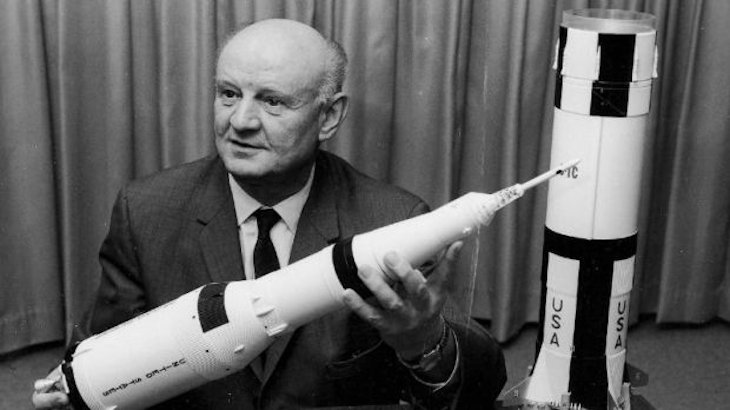 Arthur Rudolph – a prime force in the development of the V2 rocket for Nazi Germany.
Arthur Rudolph – a prime force in the development of the V2 rocket for Nazi Germany.
Photograph: National Aeronautics and Space Administration
Approximately 20,000 workers died at the camp. Yet despite the horrendous conditions for the Mittlewerk slave laborers, the factory produced high level technology and weapons. It was this expertise that the United States was willing to do anything to obtain, even ignoring the crimes of a Nazi scientist such as Rudolph.
When he was granted entry to the US under Operation Paperclip, Rudolph was described by American officials in Germany as an “ardent Nazi”. He’d personally overseen slave labor and been present when prisoners were executed. West German and American officials classified him as a war criminal. Yet these accusations were quietly erased from his official file, and Rudolph worked for NASA.
In the 1960s, Rudolph became a key engineer at the Marshall Space Flight Center in Huntsville, Alabama, managing teams of scientists working on the Saturn 5 rocket that in 1969 launched the Apollo rocket in the first manned flight to the moon.
Rudolph never made any mention of his previous job as director of Mittelwerk, where his workers were emaciated slaves in Nazi Germany, of course. Thanks to Operation Paperclip, almost nothing was known of Rudolph’s Nazi past until 1979, when the State Department’s Office of Special Investigations (OSI), charged with hunting Nazis who’d hid their past and were living in the United States, was formed.
OSI officials interviewed slave laborers from Mittelwerk and approached Rudolph with an offer: he wouldn’t be charged if he voluntarily left the United States and gave up his US citizenship. He and his wife moved back to Germany, but in 1987 a German court ruled that there was insufficient evidence to try him for war crimes. He tried for years to regain his US citizenship – helped by some former colleagues from NASA – but was unsuccessful. He died in 1996 at the age of 89.
Arthur Rudolph worked at NASA under the leadership of another “Operation Paperclip” recruit, Warner von Braun. Identified as a key asset at the close of the war because of his work on the Nazis’ V2 rocket, Braun was transferred to Garmisch-Partenkirchen, a luxurious ski town in Bavaria, for questioning by Allied forces.
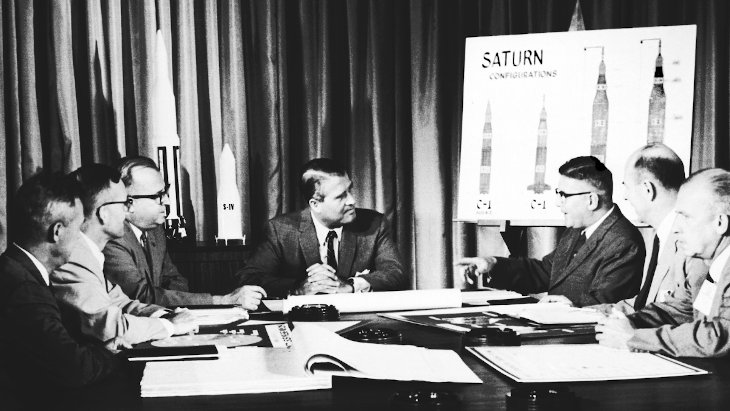 Wernher von Braun (center) in 1961 with fellow Operation Paperclip
Wernher von Braun (center) in 1961 with fellow Operation Paperclip
scientists working on a Saturn rocket.
At first he and his fellow rocket scientists refused to cooperate with their Allied captors, refusing to divulge any scientific information. He knew he held a foolproof bargaining chip: in the waning days of the war, Braun and his coworkers had hidden vital documents in an abandoned salt mine. Braun was determined to trade these papers for a new life in the United States.
After his capture, Braun “posed for endless pictures with individual GIs, in which he beamed, shook hands, pointed inquiringly at medals and otherwise conducted himself as a celebrity rather than a prisoner, treat(ing) our soldiers with the affable condescension of a visiting congressman,” remembered one disgusted American Counterintelligence Corps official (quoted in Operation Paperclip).
Braun was brought to the US in 1945 and for the next fifteen years he worked for the US Army, most notably as chief of the US Army ballistic weapon program. He oversaw teams that developed the Redstone, Jupiter-C, Juno and Pershing missile systems. Under his command, an incredible 120 former Nazi scientists worked on these and other jet systems.
In 1977 Braun even received the Presidential Medal of Freedom, the United States’ highest civilian honor.
An affable and charismatic figure, Braun wrote popular books and articles on space flight, and became a well-known figure explaining the burgeoning space program to the American public. In the 1960s, he moved to Huntsville, Alabama, and became Director of NASA’s Marshall Space Flight Center, where the Saturn space boosters that enabled manned space flight were produced. A beloved figure, in 1977 Braun even received the Presidential Medal of Freedom, the United States’ highest civilian honor.
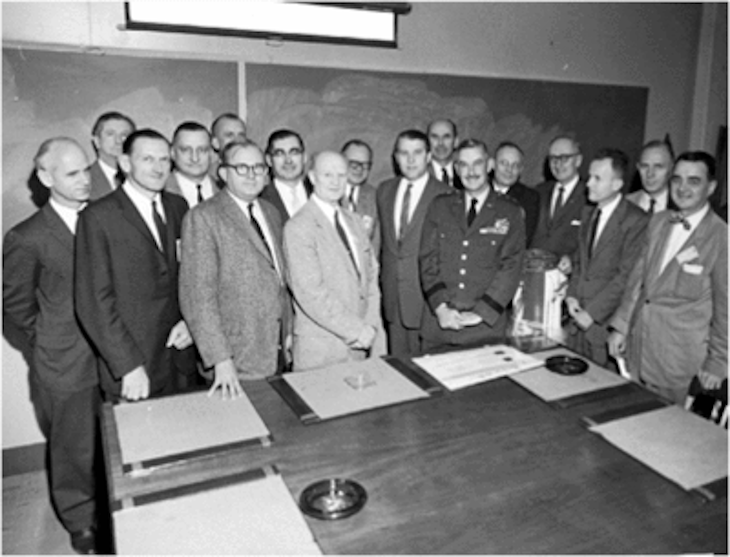 Wernher von Braun and his team in the fall of 1959 in Huntsville, Alabama. Those in the photograph have been identified as Ernst Stuhlinger, Frederick von Saurma, Fritz Mueller, Hermann Weidner, Erich W. Neubert (partially hidden), W.A. Mrazek, Karl Heimburg, Arthur Rudolph, Otto Hoberg, von Braun, Oswald Lange, General Bruce Medaris, Helmut Hoelzer, Hans Maus, E.D. Geissler, Hans Hueter, and George Constan.
Wernher von Braun and his team in the fall of 1959 in Huntsville, Alabama. Those in the photograph have been identified as Ernst Stuhlinger, Frederick von Saurma, Fritz Mueller, Hermann Weidner, Erich W. Neubert (partially hidden), W.A. Mrazek, Karl Heimburg, Arthur Rudolph, Otto Hoberg, von Braun, Oswald Lange, General Bruce Medaris, Helmut Hoelzer, Hans Maus, E.D. Geissler, Hans Hueter, and George Constan.
Braun acknowledged he’d been a member of the Nazi party, but claimed he’d never been a true believer and had no choice. He insisted that research, not politics, was his passion.
However, there was much more to Braun than this whitewashed version of his history, and the US Army and Operation Paperclip enabled him to evade justice. Far from being an unwilling Nazi, Braun was a member of the feared SS. Instead of being unaware of the horrors of Hitler’s “Final Solution” of murder and destruction, Braun actually visited the Buchenwald concentration camp to personally select workers to become slave laborers in his V2 rocket program.
His SS officer rank and Nazi records were classified by the US Army. For years, until his death in 1977, Braun was able to evade justice. He died in Alexandria, Virginia, a beloved figure. President Carter even issued an official statement after his death: “To millions of Americans, Wernher von Braun’s name was inextricably linked to our exploration of space and to the creative application of technology. Not just the people of our nation, but all the people of the world have profited from his work….”
The many unnamed victims of his torture and forced labor remained forgotten, seemingly erased from history by Operation Paperclip.
“It sometimes seems as if the Nazis had taken special pains in making practically every nightmare come true,” Dr. Leopold Alexander told his wife one day in 1945. Dr. Alexander was a Jewish doctor from Vienna. He’d escaped from Europe before the Holocaust, and made his way to America where worked in psychiatric hospitals in New England, specializing in shellshock and trauma. He volunteered for the US Army, and at the close of the war, he was sent to Europe to investigate allegations of gruesome medical experiments carried out by Nazi doctors.
One of the key doctors he interviewed was Dr. Hubertus Strughold, a senior Nazi official who oversaw a vast network of researchers who conducted experiments on hypothermia. Nazi scientists insisted to Dr. Alexander that they only conducted experiments on animals, but it soon became obvious that humans – particularly Jews – were the subjects of hundreds of sadistic medical experiments.
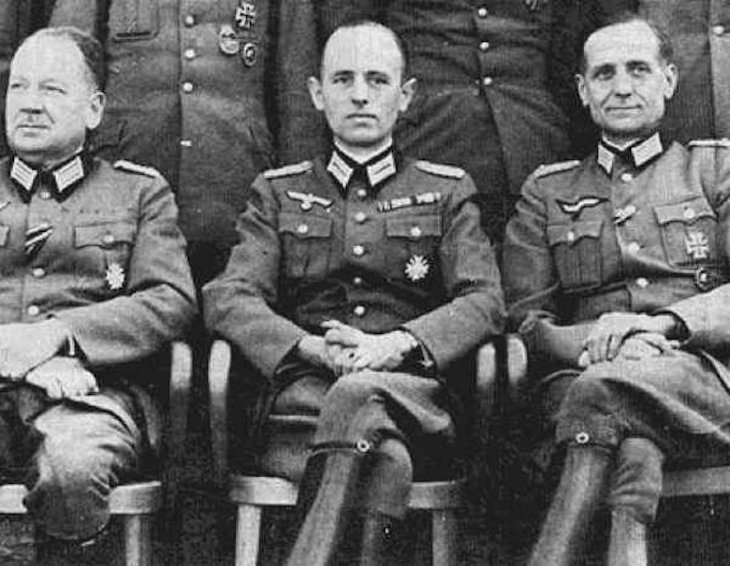 Wernher Von Braun, Arthur Rudolph, Hubertus Strughold
Wernher Von Braun, Arthur Rudolph, Hubertus Strughold
Unbeknownst to Dr. Alexander, Strughold was a long-time personal friend of a senior American military official, Lt. Col. Harry Armstrong, chief surgeon of the Eighth Air Force. While Dr. Alexander was stationed in Europe investigating war crimes and crimes against humanity, Lt. Col. Armstrong had a very different remit: to find Nazi medical researchers and bring them to the United States.
“During the war, physicians with the U.S. Army Air Forces heard rumors about cutting-edge research being developed by the (Third) Reich’s aviation doctors,” explains journalist Annie Jacobsen. These experiments were never published in mainstream medical journals, but were disseminated in Nazi magazines such as Luftfahrtmedizin (“Aviation Medicine”). Secretly, both British and US Air Forces would often translate the works and disseminate them to Allied doctors to study. With World War II coming to a close, Lt. Col. Armstrong and other US military officials wanted to get to Dr. Strughold and other Nazi scientists and bring them to America.
Lt. Col. Armstrong made Dr. Strughold a top-secret offer: no charges would be brought against him if he became co-chairman, along with Armstrong, of a new research center the American Air Force was setting up in Heidelberg called the Army Air Forces Aero Medical Center. Dr. Strughold was allowed to select the physicians he wanted to work with, and he chose 58 Nazi physicians, including some who’d worked with him on gruesome and cruel human experiments. Within a few years, many of these physicians were brought to the United States under Operation Paperclip.
In the case of Dr. Strughold, there was some difficulty in smoothing his way. The FBI had investigated him in Germany and found that he seems to have been an ardent Nazi. He’d “expressed the opinion that the Nazi party had done a great deal for Germany” and claimed that “prior to Nazism, the Jews had crowded the medical schools and it had been nearly impossible for others to enroll.” Military officials asked another German doctor, who himself had been accused of war crimes, to vouch that Dr. Strughold had high “ethical principles”. With this bogus endorsement in hand, Strughold set sail for the United States.
Strughold became Professor of Space Medicine at the U.S. Air Force School of Aerospace Medicine. In 1950, he co-founded the Space Medicine Branch of the Aerospace Medical Association. In 1963, it established the “Hubertus Strughold Award”, given each year to recognize excellence in space medicine. (In 2006 the Space Medicine Association Executive Committee debated removing Strughold’s name from the award. His Nazi past had been so thoroughly hidden, in part by the U.S. Army, that no evidence of crimes was found, and the award continued to bear Strughold’s name. After a 2012 article about Dr. Strughold’s Nazi atrocities, the award was finally suspended.)
In total, about 1,600 Nazi scientists were brought to the US under Operation Paperclip, as well as their families.
In total, about 1,600 Nazi scientists were brought to the US under Operation Paperclip, as well as their families. They evaded justice and in many cases were able to erase all mention of their Nazi pasts in their official biographies. For most of these scientists, justice never caught up and many died in America, seemingly innocent workers whose neighbors and friends and coworkers never knew the gruesome secrets in their pasts.
It was only in 2006 the Office of Special Investigations (OSI) finally succeeded in publishing an official record documenting Operation Paperclip, after objections from the Justice Department. The OSI was disbanded in 2010, but its research and the mirror it held up to America continues to shed light on Operation Paperclip and this shameful chapter in American history.
For years, Nazis “were indeed knowingly granted entry” to the United States the OSI concluded. “America, which prided itself on being a safe haven for the persecuted, became – in some small measure – a safe haven for persecutors as well.”
The purpose of Operation Paperclip was to bring over Nazi weapons scientists to America and utilize their knowledge and skills, in order to prevent the Soviet Union from recruiting them.
Some are of the opinion that Operation Paperclip was a success in some respect as the scientists’ knowledge and skills were put to good use and were a part of the building of NASA. However, there were many who protested on the basis of ethics and morality.

We need to challenge the mindset that the Americans are always the "good guys".
As Jews, we know they are not.
For 2 cents I'd dig up Von Braun's body and throw it in the dump.